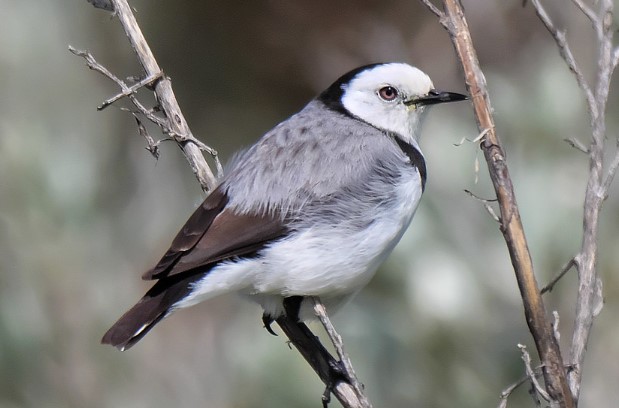Family: White-fronted chat (Epthianura albifrons) is a honeyeater of the Meliphagidae family from southern Australia.
Habitats: Southern rural Australia is home to the familiar and widespread white-fronted chat. There, the bird lives in the open fields’ heaths and the low shrubbery around lakes and swamps. After breeding, it gathers with other birds in nomadic flocks of 10 to 50 or sometimes up to several hundred, flying from one feeding area to another with jerky, high, undulating flight. This species prefers open countries with low vegetation, such as samphire (Tecticornia), tea trees (Melaleuca) and heath, salt marshes and coastal dunes, swamps or mangrove margins, and salt lakes inland.

Behavior: The white-fronted chat forages on the ground, taking insects exclusively and drinking frequently. Often, birds breed in loose colonies, just meters apart, which demonstrates their gregariousness. However, each pair has a small, discrete territory that the male defends by sitting on a vantage point, flashing his white face in different directions, and chasing away intruders. Despite the fact that the female constructs the nest, both sexes incubate and feed the young, and both feign injury if the nest is threatened. After foraging well away from the nest, non-breeding birds return to watch from a prominent twig nearby. Males are the only ones who chase off intruders.

Diet: Beetles, ants, bees, grasshoppers, moths, caterpillars, and spiders are among the insects on their diet. Acacia seeds, spiders, and nectar are also included.
Alternative Names: Several vernacular names have been given to this species. Its distinctive call led to the names (banded) tintack, gar, tang, and the male’s resemblance to a nun’s habit led to the name white-fronted nun and also called Baldy head, Tintack, Bumps, Moonbird, Ringneck, Single-bar, and Thistlebird. It is unclear how other names, such as clipper and tripper, came about.
Size: The size of the white-fronted chat is about 120-130 mm in length.
Identification: As far as identification: The MALE bird has a broad black band from the crown across the breast that encircles the white forehead, face, throat, and breast. The back is mid-grey. The wings and tail are black, except for the inner tips of the middle pair of tail feathers, which have white spots. The rest of the underparts are white. The color of the eye ranges from white to light orange. The feet and bill are black. There are no eclipse plumages. FEMALE: The opposite sex is duller than males, with a grey-brown crown, face, and back, and white underparts with a dusky band across the breast. IMMATURES: As a female, but breast band is fainter; the flanks are buffier.

Voice Call and Song: Calls consist of nasal tang, given singly, but tossed about by flocks of birds in contact, especially when flying. Notes of fussiness were also observed.
Subspecies: There are no recognized subspecies of this species; it is monotypic. There was a belief that Tasmanian birds had longer bills, but further investigation has not confirmed this.
Nesting and Breeding: White-fronted Chats nest close to the ground in low shrubberies throughout southern Australia. Breeding takes place mostly between July and January. Nests of fine twigs, rootlets, and plant stalks, lined with fine grass, hair, and sometimes flower heads, are found near the ground in saltbush, samphire, or reed clumps.
Eggs: There are two to four eggs laid by the bird, which are white with spots and blotches of black, red-black, gray, or various shades of red-brown, particularly at the larger end; oval, about 18 x 14mm. It takes 13-1 4 days for both sexes to incubate. Fourteen to fifteen days after hatching, the young fledge.
Distribution: In terms of distribution, white-fronted chat is mostly found in low shrubberies of samphire and saltbush on estuarine flats and salt lakes, moist grasslands, edges of swamps and marshes, and low heath in southern Australia to Tasmania. In more arid regions, it is mostly sedentary and nomadic.
Races: No races.







